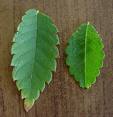Chinese Elm[]
For beginners to experts alike, the Chinese Elm is praised as one of the best, most versatile trees for bonsai cultvation. This Elm is native to East Asia, and in the wild can grow to 60 feet tall - outdoors, of course.
Appearance[]

The mottled bark of a Chinese Elm

The toothed leaves if a Chinese Elm
Bark[]
The bark is mottled with a dark gray color that is mixed with cream and red coloring. The bark of the Chinese Elm bonsai tree is the most fascinating aspect of the tree. Depending on the species, some trees have smooth bark and some rough, almost cork-like looking bark. With the cracked type, it will become even more deeply fissured as the tree ages, giving it yet more enriched character. However, with the Chinese Elm bonsai tree the smoother the bark the less hardy the tree.
Decidous/Evergreen?[]
The Chinese Elm can remain semi-evergreen, as long as the tree isn't exposed to the colder, shortening days of winter, triggering dormancy.
Leaves
Leaves are small, dark green, and have a leathery appearance with a shiny top side and small, blunt teeth.Chinese Elm is not prone to Dutch Elm Disease. Because of this, the Chinese Elm makes an excellent plant for people just starting out growing bonsai. The growth pattern is highly predictable and you do not have to be an expert at pruning because this tree is very forgiving. Additionally, the Chinese Elm bonsai tree is fast-growing, allowing you time to become accustomed to training and caring.
Care[]
Whilst caring for a Chinese Elm bonsai tree, it must be protected from harsh conditions, as well as cold weather.
Pruning[]
To prune, the best time is after the growth period, which would be in the early spring months. When pruning, leave 1-2 nodes located closest to the main branch or trunk.
Watering[]
The Chinese Elm bonsai tree will need moderate water throughout the year. The key is to keep the tree moist at all times but not over watered.Check the surface of the soil by pressing down lightly with a fingertip. When the soil feels dry to touch, water it. This can be done by standing the tree-and pot- in a container of water, where the water level is up to the rim of the pot, for 10 minutes/until the tree is saturated. If you live in a soft-water area, water the tree by spring,rain or tap water, but if you live in hard-water areas then it is best to avoid tap-water if possible.
Feeding[]
Feed weekly, but not when out of leaf.
Wiring
Wiring is best carried out when the tree is out of leaf. Remember, the bark marks easily so be very careful with the process.
Repotting[]
Repotting should be carried out when the tree becomes root bound. This is best carried out in spring, just as the leaf buds are extending.
Tree Placement[]
Outdoors: Full sun or partial shade. Will need winter protection below -5°c.
Indoors: Place where it will get the most direct sunlight. Avoid spots above radiators or too close to very cold windows in the winter.
Genus[]
The Chinese Elm falls in the Ulmus species that includes more than 45 species of deciduous, semi-evergreen trees. These trees are known for alternating ovate to elliptic toothed leaves with incredible fall color display.